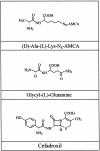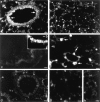Localization of the peptide transporter PEPT2 in the lung: implications for pulmonary oligopeptide uptake
- PMID: 11159208
- PMCID: PMC1850326
- DOI: 10.1016/S0002-9440(10)64013-8
Localization of the peptide transporter PEPT2 in the lung: implications for pulmonary oligopeptide uptake
Abstract
Pulmonary delivery of peptidomimetic antibiotics is frequently used for local drug therapy in pulmonary infections. Identification of transport pathways into airway epithelia can lead to new strategies of therapy. Here we describe the distribution of the beta-lactam-transporting high-affinity proton-coupled peptide transporter PEPT2 in mammalian lungs. Using reverse transcriptase-polymerase chain reaction and Northern blot analysis, PEPT2-mRNA was detected in lung extracts. The expression of PEPT2-mRNA and protein was localized to alveolar type II pneumocytes, bronchial epithelium, and endothelium of small arteries of rat lung by nonisotopic in situ hybridization and immunohistochemistry. In addition, transport studies using murine whole-organ preparations revealed transporter-mediated uptake of a fluorophore-conjugated dipeptide derivative into bronchial epithelial cells and type II pneumocytes. This transport was competitively inhibited by cephalosporins and dipeptides that are reported as PEPT2-carried substrates. Cell specificity of the PEPT2-mediated uptake pattern was confirmed by double labeling with Lycopersicon esculentum lectin. Together these data suggest that PEPT2 is the molecular basis for the transport of peptides and peptidomimetics in pulmonary epithelial cells. In conclusion PEPT2 may be an interesting target for pulmonary delivery of peptides and peptidomimetics.
Figures







Similar articles
-
Functional expression of the peptide transporter PEPT2 in the mammalian enteric nervous system.J Comp Neurol. 2005 Sep 12;490(1):1-11. doi: 10.1002/cne.20617. J Comp Neurol. 2005. PMID: 16041713
-
Peptide transport in the mammary gland: expression and distribution of PEPT2 mRNA and protein.Am J Physiol Endocrinol Metab. 2002 May;282(5):E1172-9. doi: 10.1152/ajpendo.00381.2001. Am J Physiol Endocrinol Metab. 2002. PMID: 11934684
-
Direct visualization of peptide uptake activity in the central nervous system of the rat.Neurosci Lett. 2004 Jun 24;364(1):32-6. doi: 10.1016/j.neulet.2004.04.013. Neurosci Lett. 2004. PMID: 15193750
-
Molecular mechanisms of pulmonary peptidomimetic drug and peptide transport.Am J Respir Cell Mol Biol. 2004 Mar;30(3):251-60. doi: 10.1165/rcmb.2003-0315TR. Am J Respir Cell Mol Biol. 2004. PMID: 14969997 Review.
-
Novel strategies of aerosolic pharmacotherapy.Exp Toxicol Pathol. 2006 Jun;57 Suppl 2:49-53. doi: 10.1016/j.etp.2006.02.007. Epub 2006 Mar 31. Exp Toxicol Pathol. 2006. PMID: 16580826 Review.
Cited by
-
Molecular mechanisms of severe acute respiratory syndrome (SARS).Respir Res. 2005 Jan 20;6(1):8. doi: 10.1186/1465-9921-6-8. Respir Res. 2005. PMID: 15661082 Free PMC article. Review.
-
Immunocytochemistry for bestatin and its application to drug accumulation studies in rat intestine and kidney.J Mol Histol. 2011 Dec;42(6):589-96. doi: 10.1007/s10735-011-9365-z. Epub 2011 Oct 18. J Mol Histol. 2011. PMID: 22006287
-
The proton oligopeptide cotransporter family SLC15 in physiology and pharmacology.Pflugers Arch. 2004 Feb;447(5):610-8. doi: 10.1007/s00424-003-1101-4. Epub 2003 Aug 7. Pflugers Arch. 2004. PMID: 12905028 Review.
-
Expression of immediate early genes in sensory ganglia.Neurochem Res. 2001 Oct;26(10):1113-7. doi: 10.1023/a:1012366721845. Neurochem Res. 2001. PMID: 11700953
-
Renal assimilation of short chain peptides: visualization of tubular peptide uptake.Pharm Res. 2002 Aug;19(8):1209-14. doi: 10.1023/a:1019810512519. Pharm Res. 2002. PMID: 12240948
References
-
- Kemp PJ, Boyd CA: Pathways for glucose transport in type II pneumocytes freshly isolated from adult guinea pig lung. Am J Physiol 1992, 263:L612-L616 - PubMed
-
- Bai C, Brown LA, Jones DP: Glutathione transport by type II cells in perfused rat lung. Am J Physiol 1994, 267:L447-L455 - PubMed
-
- Brown SE, Kim KJ, Goodman BE, Wells JR, Crandall ED: Sodium-amino acid cotransport by type II alveolar epithelial cells. J Appl Physiol 1985, 59:1616-1622 - PubMed
-
- Helliwell PA, Meredith D, Boyd CA, Bronk JR, Lister N, Bailey PD: Tripeptide transport in rat lung. Biochim Biophys Acta 1994, 1190:430-434 - PubMed
Publication types
MeSH terms
Substances
LinkOut - more resources
Full Text Sources

